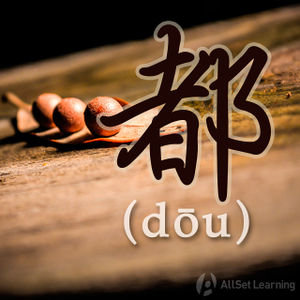Difference between revisions of "Emphasizing quantity with "dou""
| Line 18: | Line 18: | ||
<div class="liju"> | <div class="liju"> | ||
| − | * 很 多 人 <em>都</em> 想 减肥。 | + | * 很 多 人 <em>都</em> 想 减肥。<span class="trans">A lot of people want to lose weight.</span> |
| − | * 大家 <em>都</em> 应该 知道。 | + | * 大家 <em>都</em> 应该 知道。<span class="trans">Everyone should know.</span> |
| − | * 爱尔兰人 <em>都</em> 喜欢 喝 啤酒。 | + | * 爱尔兰人 <em>都</em> 喜欢 喝 啤酒。<span class="trans">Irish people all like drinking beer.</span> |
</div> | </div> | ||
Revision as of 02:09, 4 June 2013
-
Level
-
Similar to
-
Used for
-
Keywords
都 is one of those characters that on the surface may seem simple, but actually has many different subtle uses. In this article, we will look at using 都 to emphasize quantity.
Structure
You can use 都 (dōu) to emphasis the large quantity of something, particularly a group of people. The subject should be some sort of large group (like a majority of people or things), e.g. "很多人" or "大部分".
Subject + 都 + Verb + Object
Examples
- 很 多 人 都 想 减肥。A lot of people want to lose weight.
- 大家 都 应该 知道。Everyone should know.
- 爱尔兰人 都 喜欢 喝 啤酒。Irish people all like drinking beer.



